Why Competitors’ Blogs Rank Higher (7 SEO Steps to Beat Them)
Sep 15, 2025 | By Ahmed Sohail
Ever Googled a question about your industry, only to see your competitors’ blogs owning the first page of results—while your content lingers on page 3, unseen and unloved?
It’s frustrating, isn’t it? You put in the hours writing articles, maybe even hire a writer, hit “publish,” and wait for the clicks. But instead, crickets.
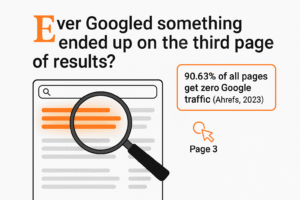
Here’s the reality: 90.63% of all pages get zero traffic from Google (Ahrefs, 2023). That means if your competitors are ranking, they’re doing something right—and you’re likely missing critical SEO and content strategy steps.
But don’t worry. You’re not alone. In fact, most businesses are in the same boat. And today, we’re going to pull back the curtain, decode why your competitors are outranking you, and map out a clear, step-by-step strategy to change that.
So grab your coffee. Let’s dive in.
Section 1: The Problem — Why It Hurts When Competitors Rank Higher
Ranking lower than your competitors isn’t just an ego bruise—it’s a direct business loss.
- 75% of users never scroll past the first page of Google (HubSpot, 2023).
- The #1 result gets 27.6% of all clicks (Backlinko, 2023).
- By the time you’re in position #5, you’re down to 6% of clicks.
That means if your competitor is sitting in the top 3, they’re siphoning off leads, sales, and brand trust that could’ve been yours.
Imagine two stores on the same street. One has a huge neon sign right at eye level. The other has a dusty sign hidden behind a tree. Which store do you think gets more walk-ins? That’s exactly what search rankings are like.
When your competitors dominate Google:
- They get more traffic.
- They build more authority.
- They close more deals.
- And over time, they make it harder for you to catch up.
This is the silent battle happening online every day. And if you don’t understand why you’re losing, you’ll keep writing articles that never see the light of day.
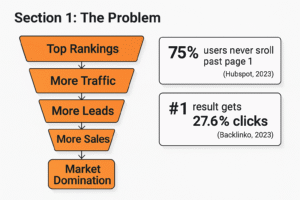
Section 2: The “Why” — What’s Really Going On Behind the Rankings
So why are your competitors always above you? Here are the most common reasons:
1. They’re Not Just Writing — They’re Optimizing
Most business owners think blogging is just about putting words on a page. But SEO is 80% optimization, 20% writing. Competitors often use:
- Keyword research tools (SEMrush, Ahrefs, Ubersuggest).
- Optimized meta titles and descriptions.
- Proper use of headers (H1, H2, H3).
2. They Understand Search Intent
Google rewards pages that best match what the searcher wants. If someone types “best CRM for startups,” Google won’t rank your generic “What is a CRM?” article. Competitors nail intent alignment, and that’s why they win.
3. They Have Strong Backlinks
Backlinks are like votes of confidence from other websites. According to a study by Moz, backlinks remain one of the top 3 ranking factors. If your competitor has been around longer or has PR/media coverage, their backlink profile gives them an edge.
4. They Publish Consistently
Google favors websites that show up regularly. If your competitor is publishing 3 blogs a week and you post once a month, guess who’s more likely to dominate?
5. They Invest in Content Promotion
Most people hit “publish” and wait. Competitors push their content:
- Social media distribution.
- Paid ads to boost visibility.
- Email marketing campaigns.
6. They Leverage Better User Experience (UX)
Google looks at metrics like bounce rate, dwell time, and click-through rate (CTR). If your competitor’s site loads faster and has better design, Google rewards them.
7. They’re Data-Driven, Not Guessing
Competitors track performance, run A/B tests, and refine strategies. They treat SEO like science—not luck.

Section 3: The Ultimate Guide — 7 Steps to Outrank Your Competitors
Here’s the good news: you can beat your competitors. It’s not magic; it’s method.
Step 1: Master Keyword Research

Think of keywords as the language of your customers.
- Use tools like Ahrefs or SEMrush.
- Look for long-tail keywords (e.g., “affordable CRM for small law firms”) instead of broad terms (“CRM software”).
- Spy on competitors: What keywords are they ranking for?
👉 Action Tip: Start with 10-20 “low competition, high intent” keywords and build content around them.
Step 2: Create 10x Content

If your competitor’s article is 1,500 words, make yours 3,000—but don’t just add fluff. Add depth, visuals, statistics, expert quotes, and case studies.
Brian Dean (Backlinko) calls this the Skyscraper Technique: build something taller, stronger, and more detailed.
👉 Action Tip: Always ask: “If I were a reader, would I bookmark this?” If not, keep building.
Step 3: Optimize Like a Pro

Every article should have:
- A clear meta title (70 characters max).
- A compelling meta description (160 characters).
- One main keyword in H1, 2–3 in H2s.
- Internal links (to your own pages).
- External links (to authority sources).
👉 Action Tip: Use free tools like Yoast SEO (WordPress) or RankMath to optimize before hitting publish.
Step 4: Build Backlinks Strategically
Backlinks don’t just “happen.” You need a plan.
- Guest posting on industry blogs.
- HARO (Help a Reporter Out): journalists need experts—be one.
- Resource pages: get listed on “Best Tools for…” articles.
👉 Action Tip: Set a goal of 5-10 backlinks per month.
Step 5: Improve User Experience

- Ensure site speed (use Google PageSpeed Insights).
- Mobile-first design.
- Clean navigation.
👉 Action Tip: A/B test your headlines. Higher CTR = better rankings.
Step 6: Promote Relentlessly

Your content is only 50% done when you hit publish.
- Share on LinkedIn, Twitter, and niche forums.
- Send to your email list.
- Run low-budget Facebook/Google ads to amplify reach.
👉 Action Tip: Create 3-5 snippets (quotes, infographics, carousels) from each blog to repurpose on social media.
Step 7: Track, Measure, Repeat
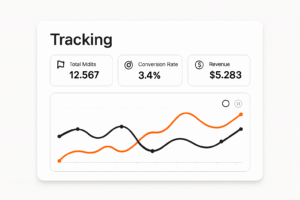
SEO isn’t “set it and forget it.”
- Use Google Analytics and Search Console.
- Track keyword rankings monthly.
- Update old articles with fresh stats every 6-12 months.
👉 Action Tip: Create a content calendar with quarterly review checkpoints.
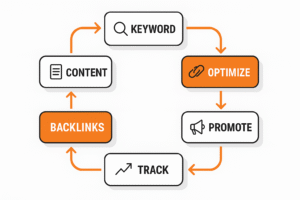
Section 4: Case Studies & Real-World Examples
Case Study 1: The SaaS Startup That Beat Giants
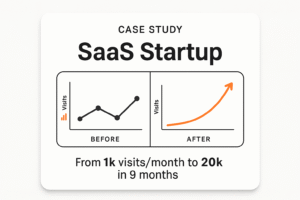
A small SaaS company in India was struggling against HubSpot. Instead of competing for “CRM software,” they targeted long-tail queries like “CRM for freelancers.” Within 9 months, they ranked #1 for 15+ long-tail keywords, driving 20k monthly visits.
Case Study 2: The Local Bakery That Went National

A bakery in London started blogging about “gluten-free baking tips”. By publishing 2 optimized articles per week and sharing them on Instagram, they landed features in food magazines, earning backlinks. Traffic grew 300% in 6 months.
Case Study 3: The E-Commerce Brand Using the Skyscraper Method
An e-commerce site selling eco-friendly packaging noticed competitors ranking with weak guides. They created a comprehensive 5,000-word resource, with visuals and case studies. Result: #1 ranking in 4 months and a 40% bump in sales.
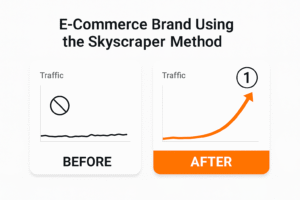
Section 5: The Future — What’s Next in SEO
Search Engine Optimization is evolving fast. Here’s what to watch:
- AI & Search (SGE): Google’s AI-driven answers will change how results look. Content must be authoritative, original, and human-centric.
- Voice Search: By 2026, 55% of households will use voice assistants (Statista). Optimize for conversational queries.
- EEAT (Experience, Expertise, Authoritativeness, Trust): Google wants real experts, not just keyword-stuffed blogs. Showcase credentials.
- Video + Interactive Content: Blogs aren’t enough. Mix in videos, infographics, and tools to stay ahead.

Conclusion: Your Turn to Take the Top Spot
If your competitors’ blogs are always ranking higher, it’s not because they’re smarter—it’s because they’re strategic.
- They research, optimize, and promote.
- They invest in backlinks and UX.
- They measure and refine.
Now, with the 7-step roadmap we covered, you can flip the script.
👉 Don’t just publish. Publish with purpose.
👉 Don’t just compete. Dominate.
Your next move? Start with one article. Apply these strategies. Watch what happens over the next 90 days.
And remember—SEO is a marathon, not a sprint. But every marathon is won one step at a time.
If this article helped you, share it with a friend who’s struggling with Search Engine Optimization. And if you want personalized help climbing the rankings, contact us for Fully SEO services & don’t forget to comment below or subscribe to our newsletter for weekly insider strategies.
![]()
Stats Used (with sources):
- Ahrefs: 90.63% of pages get no traffic (2023)
- HubSpot: 75% don’t scroll past page 1 (2023)
- Backlinko: #1 result gets 27.6% clicks (2023)
- Moz: Backlinks still top 3 ranking factor (2023)
- Statista: 55% households will use voice assistants by 2026

Want to grow your business online?
I’m Ahmed Sohail, and I’m helping businesses grow with determined results. My question is, does your business needs growth?
Contact Now


